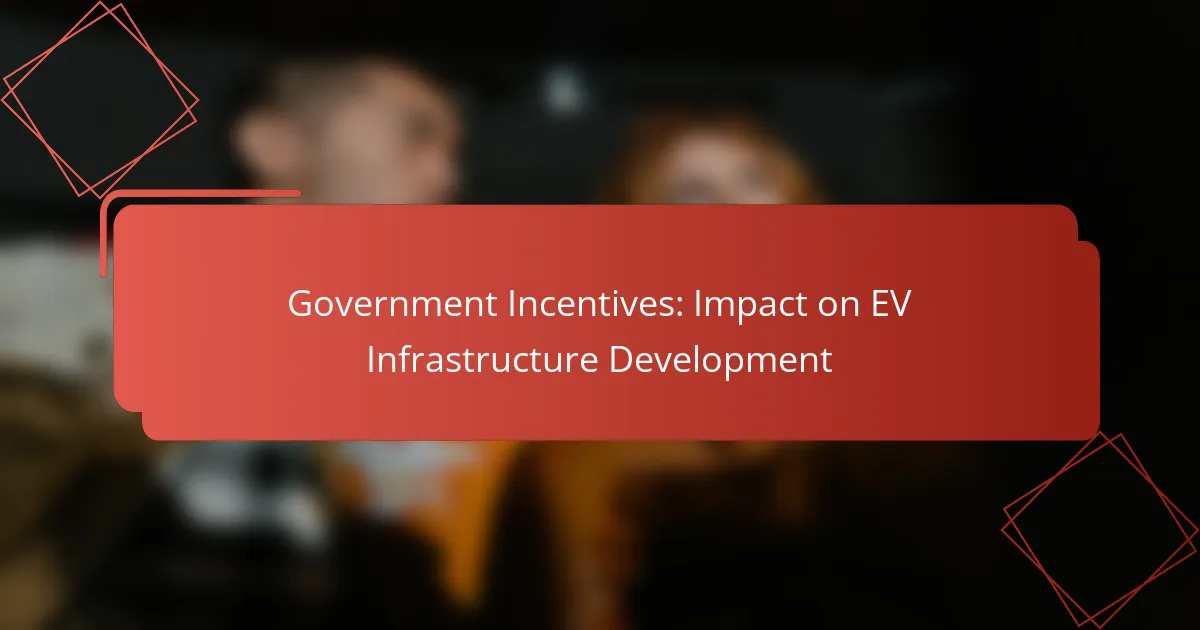Government incentives play a crucial role in the development of electric vehicle (EV) infrastructure by offering financial support that stimulates investment in charging stations and related facilities. These incentives, which can include funding, tax credits, and partnerships, are designed to enhance the availability and accessibility of EV charging options, ultimately facilitating the transition to cleaner transportation. States like California, New York, and Texas exemplify robust incentive programs that promote the expansion of charging networks and encourage EV adoption.
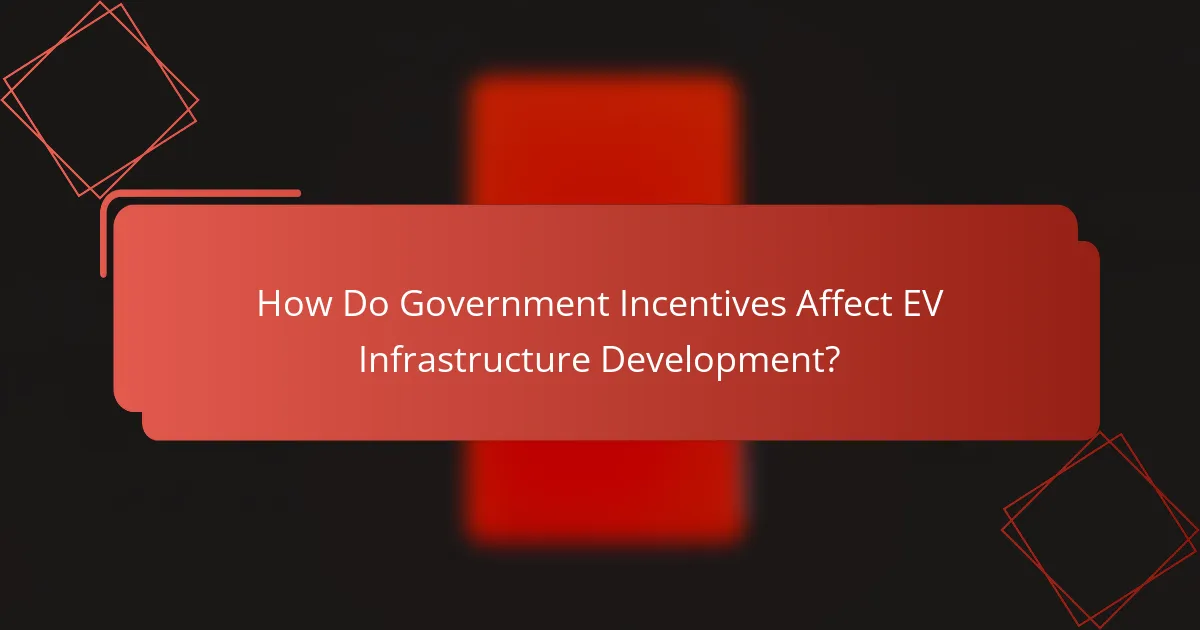
How Do Government Incentives Affect EV Infrastructure Development?
Government incentives significantly boost the development of electric vehicle (EV) infrastructure by providing financial support and encouraging investment in charging stations and related facilities. These incentives can take various forms, including funding, tax credits, and partnerships, all aimed at expanding the availability and accessibility of EV charging options.
Increased funding for charging stations
Increased funding for charging stations is a primary way government incentives impact EV infrastructure. This funding often comes from federal or state budgets, aimed at subsidizing the installation of public charging points. For instance, grants may cover a substantial portion of the installation costs, making it more feasible for businesses and municipalities to invest in charging infrastructure.
Governments may also establish programs that allocate specific amounts per charging station installed, which can range from a few thousand to tens of thousands of dollars depending on the location and type of charger. This financial support encourages a wider rollout of charging stations, especially in underserved areas.
Tax credits for EV buyers
Tax credits for EV buyers directly influence the demand for electric vehicles, which in turn drives the need for more charging infrastructure. These credits can significantly reduce the purchase price of EVs, making them more attractive to consumers. For example, in the United States, buyers may receive credits of several thousand dollars, depending on the model and battery capacity.
As more consumers purchase EVs due to these incentives, the demand for charging stations increases, prompting local governments and businesses to invest in expanding the infrastructure. This creates a positive feedback loop where higher EV adoption leads to more charging options, further encouraging EV purchases.
Grants for local governments
Grants for local governments are essential for developing EV infrastructure at the community level. These grants can fund projects that install charging stations in public areas, such as parks, libraries, and government buildings. By providing financial resources, governments empower local authorities to take initiative in promoting EV use.
Local governments can utilize these grants to create comprehensive plans for EV infrastructure, ensuring that charging stations are strategically placed to meet community needs. This can include prioritizing areas with high traffic or proximity to public transportation hubs to maximize accessibility for EV users.
Partnerships with private companies
Partnerships with private companies enhance the effectiveness of government incentives in developing EV infrastructure. By collaborating with businesses, governments can leverage additional funding and expertise to expand charging networks. For instance, a city might partner with a charging network provider to install stations at commercial properties, sharing costs and responsibilities.
These partnerships can also lead to innovative solutions, such as integrating charging stations with renewable energy sources or smart grid technology. Such collaborations not only improve infrastructure but also promote sustainability and efficiency in energy use, aligning with broader environmental goals.
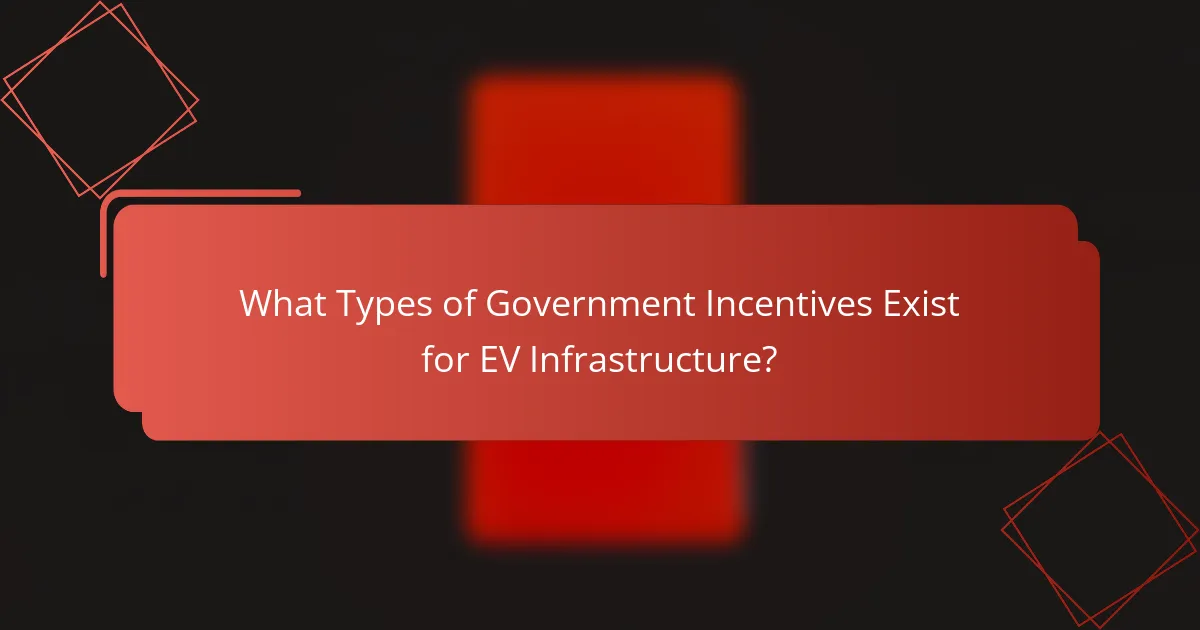
What Types of Government Incentives Exist for EV Infrastructure?
Government incentives for electric vehicle (EV) infrastructure include various financial supports designed to encourage the development and expansion of charging networks. These incentives can significantly reduce the costs associated with installing and maintaining EV charging stations, making it easier for businesses and municipalities to invest in this technology.
Federal tax incentives
Federal tax incentives for EV infrastructure primarily come in the form of tax credits for the installation of charging stations. For instance, businesses can receive a tax credit of up to 30% of the installation costs, capped at a certain amount per station. This can lead to substantial savings, especially for larger installations.
Additionally, the federal government may offer grants and funding opportunities through programs like the Department of Energy’s EV Charging and Fueling Infrastructure Program. These programs aim to support the deployment of charging stations across the country.
State rebates and grants
Many states provide their own rebates and grants to further incentivize EV infrastructure development. These state-level incentives can vary widely, with some states offering rebates that cover a significant portion of installation costs, while others may provide fixed amounts per charging station. For example, California has been known to offer rebates that can reach several thousand dollars per station.
States may also have specific programs targeting underserved areas, ensuring equitable access to EV charging. It’s crucial for businesses and local governments to research their specific state’s offerings, as these can change frequently and may have specific eligibility requirements.
Local government initiatives
Local governments often implement initiatives to promote EV infrastructure within their communities. This can include direct funding for charging stations, zoning changes to facilitate installation, or partnerships with private companies to expand charging networks. For example, some cities have launched programs that provide free or subsidized charging stations in public areas.
Additionally, local governments may offer incentives such as reduced permitting fees or expedited approval processes for EV infrastructure projects. Engaging with local authorities can help stakeholders understand available resources and navigate the regulatory landscape effectively.
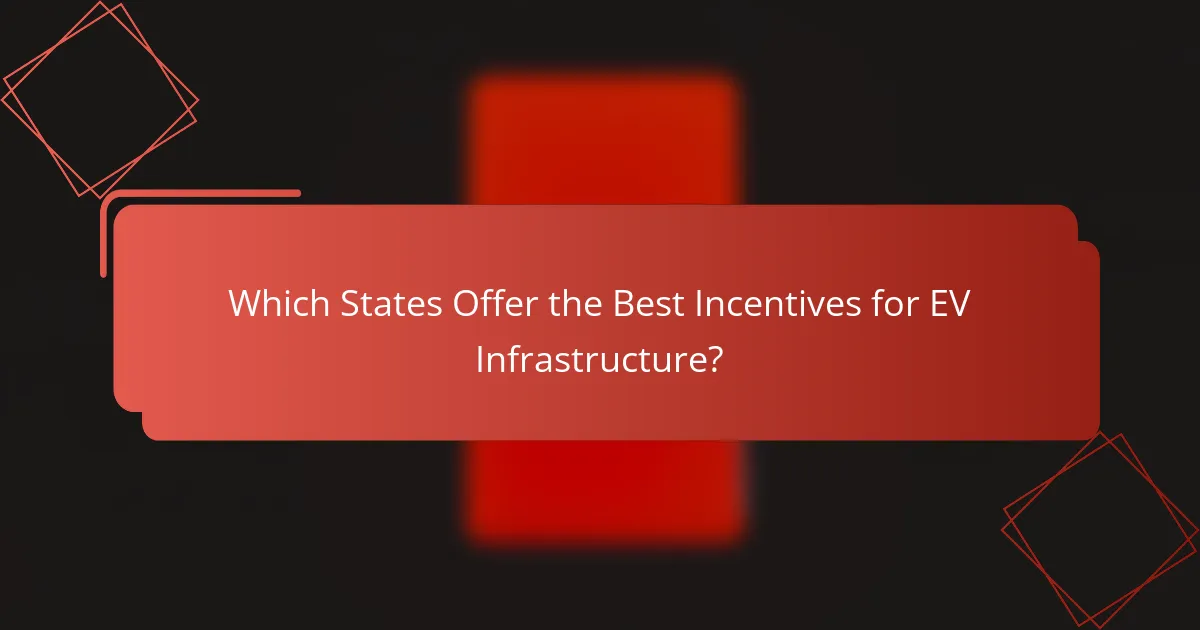
Which States Offer the Best Incentives for EV Infrastructure?
California, New York, and Texas provide some of the most robust incentives for electric vehicle (EV) infrastructure development. These states have implemented various programs aimed at enhancing charging networks and promoting EV adoption through financial support and grants.
California’s Clean Vehicle Rebate Project
California’s Clean Vehicle Rebate Project (CVRP) offers rebates for the purchase or lease of eligible electric vehicles, which can indirectly support EV infrastructure by increasing the number of EVs on the road. The program provides rebates that can range from a few thousand dollars, depending on the vehicle type and the buyer’s income.
Additionally, California has invested heavily in expanding its charging network, with numerous public charging stations available across the state. This infrastructure is crucial for supporting the growing number of EVs and ensuring that drivers have convenient access to charging options.
New York’s Charge NY program
New York’s Charge NY program aims to install thousands of charging stations throughout the state, making it easier for EV owners to find charging options. The program includes funding for both public and private charging infrastructure, with incentives available for businesses and municipalities that participate.
Through this initiative, New York has set a goal to have at least 10,000 charging stations by 2021, significantly enhancing the state’s EV infrastructure. This ambitious target helps to alleviate range anxiety for potential EV buyers and encourages more residents to consider electric vehicles.
Texas’s EV infrastructure grants
Texas offers various grants for EV infrastructure development, particularly through its Electric Vehicle Infrastructure Grant Program. This program provides funding to local governments and organizations to build charging stations, with grants typically covering a significant portion of the installation costs.
By focusing on expanding charging access in both urban and rural areas, Texas aims to create a comprehensive network that supports EV adoption across the state. Stakeholders should be aware of application deadlines and eligibility criteria to maximize their chances of receiving funding for their projects.
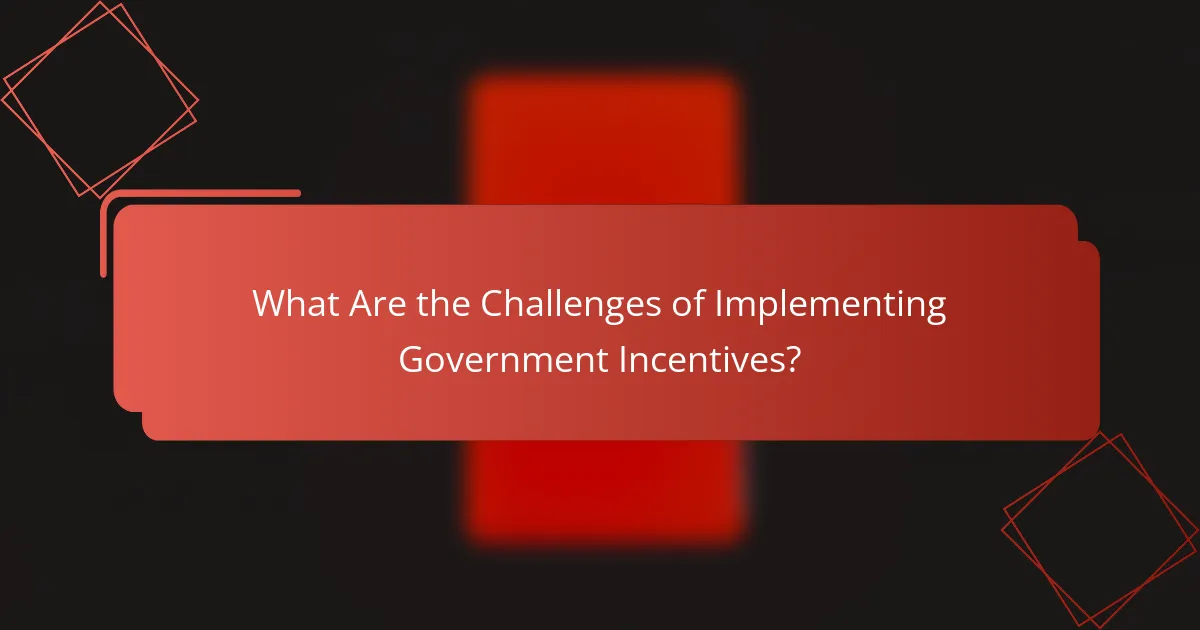
What Are the Challenges of Implementing Government Incentives?
Implementing government incentives for electric vehicle (EV) infrastructure faces several challenges that can hinder their effectiveness. Key issues include funding limitations, regulatory hurdles, and the need for greater public awareness and adoption of EV technologies.
Funding limitations
Funding limitations are a significant barrier to the successful implementation of government incentives for EV infrastructure. Many governments operate under tight budgets, which can restrict the amount of financial support available for EV projects. This can lead to insufficient charging stations and slow infrastructure development.
Moreover, the allocation of funds often competes with other pressing needs, such as healthcare and education. To overcome this, stakeholders should advocate for dedicated funding streams or public-private partnerships that can leverage additional resources for EV infrastructure.
Regulatory hurdles
Regulatory hurdles can complicate the deployment of EV infrastructure, as different jurisdictions may have varying requirements and standards. These inconsistencies can delay project approvals and increase costs for developers. For instance, local zoning laws may restrict the installation of charging stations in certain areas.
To navigate these challenges, it is essential for policymakers to streamline regulations and create uniform standards that facilitate the rapid expansion of EV infrastructure. Engaging with industry stakeholders can help identify and address specific regulatory bottlenecks.
Public awareness and adoption
Public awareness and adoption of electric vehicles are critical for the success of government incentives aimed at expanding EV infrastructure. Many potential users are still unaware of the benefits of EVs or how to access charging facilities. This lack of knowledge can result in lower adoption rates, undermining the effectiveness of incentives.
To improve public awareness, governments should invest in educational campaigns that highlight the advantages of EVs, such as lower operating costs and environmental benefits. Additionally, providing clear information on available incentives and charging locations can encourage more consumers to transition to electric vehicles.
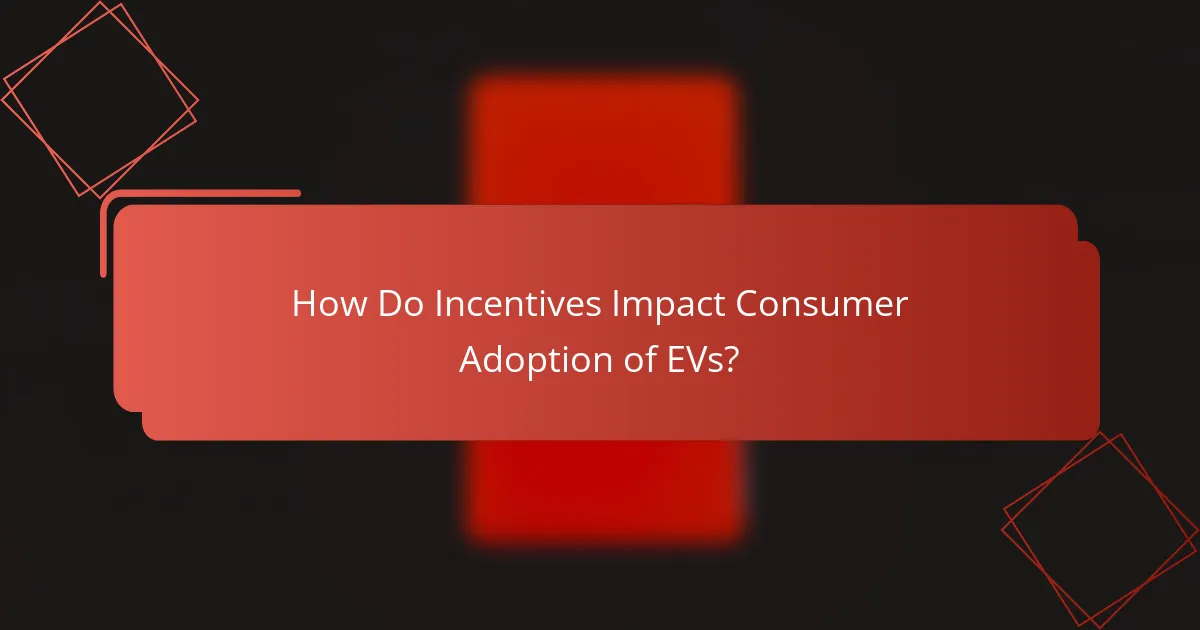
How Do Incentives Impact Consumer Adoption of EVs?
Government incentives significantly enhance consumer adoption of electric vehicles (EVs) by reducing costs and increasing confidence in the technology. These incentives often come in the form of tax credits, rebates, and grants, making EVs more financially accessible and appealing to a wider audience.
Lower upfront costs
One of the primary ways incentives impact consumer adoption is by lowering the upfront costs associated with purchasing an EV. Financial incentives can reduce the purchase price by thousands of dollars, making EVs competitive with traditional gasoline vehicles. For example, in the United States, federal tax credits can range from $2,500 to $7,500 depending on the vehicle’s battery capacity.
Additionally, some states offer their own rebates or incentives, which can further decrease the initial investment. Consumers should research local programs to maximize savings when purchasing an EV.
Increased consumer confidence
Incentives also foster increased consumer confidence in EV technology. Knowing that financial support is available can reassure potential buyers about their investment. This confidence is bolstered by the perception that the government supports the transition to cleaner transportation.
Moreover, incentives often come with additional benefits, such as access to carpool lanes or reduced registration fees, which enhance the overall value proposition of owning an EV. Consumers are more likely to consider an EV when they see tangible benefits beyond just the vehicle itself.
Broader market acceptance
As more consumers adopt EVs due to incentives, market acceptance grows, leading to a positive feedback loop. Increased demand encourages manufacturers to invest in EV technology and infrastructure, resulting in more model options and improved charging networks. This broader acceptance can help normalize EVs as a standard choice for consumers.
Furthermore, as the market expands, economies of scale can drive down costs, making EVs even more affordable for future buyers. Communities may also see more charging stations and support services, enhancing the overall EV ownership experience.
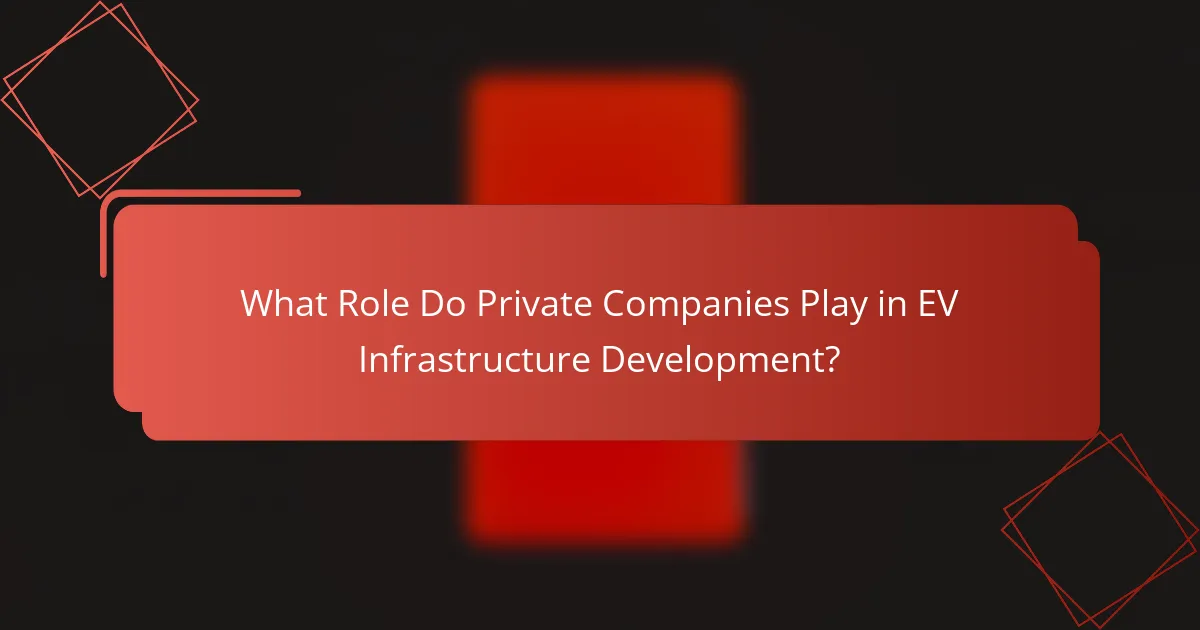
What Role Do Private Companies Play in EV Infrastructure Development?
Private companies are crucial in developing electric vehicle (EV) infrastructure, as they invest in charging stations, technology, and services that support EV adoption. Their involvement often complements government initiatives, driving innovation and expanding the network of charging options available to consumers.
Collaboration with government
Private companies frequently collaborate with government entities to enhance EV infrastructure. This partnership can involve funding, shared resources, and aligning on regulatory standards to ensure a cohesive approach to EV development.
For example, a private charging network may work with local governments to identify optimal locations for charging stations, often leveraging public land or facilities. These collaborations can lead to incentives such as tax breaks or grants, making investments more attractive for private firms.
To maximize the benefits of such collaborations, companies should actively engage with government agencies early in the planning process. Understanding local regulations and available incentives can streamline deployment and enhance project viability.
